Religion Roman Catholic Name Pedro de | ||
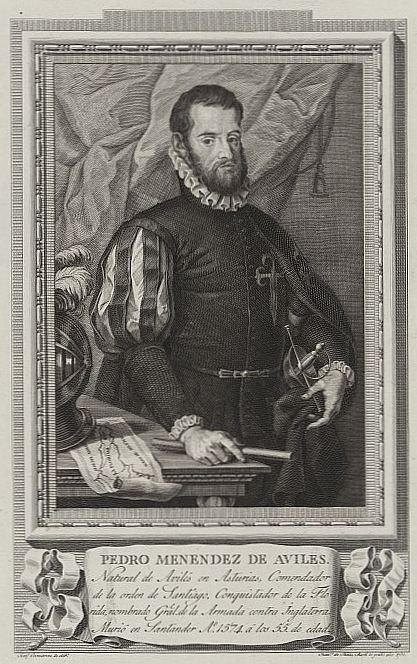 | ||
Occupation | ||
Ponce de leon pedro menendez de aviles in st augustine florida
Pedro Menéndez de Avilés (15 February 1519 – 17 September 1574) was a Spanish admiral and explorer from the region of Asturias, Spain, who is remembered for planning the first regular trans-oceanic convoys and for founding St. Augustine, Florida, in 1565. This was the first successful Spanish settlement in La Florida and the most significant city in the region for nearly three centuries. St. Augustine is the oldest continuously-inhabited, European-established settlement in the continental United States. Menéndez de Avilés was also the first governor of Florida (1565–74).
Contents
- Ponce de leon pedro menendez de aviles in st augustine florida
- Pedro menendez de aviles
- Biography
- La Florida
- Military
- Treasure fleet
- Later years
- Family
- Legacy
- References
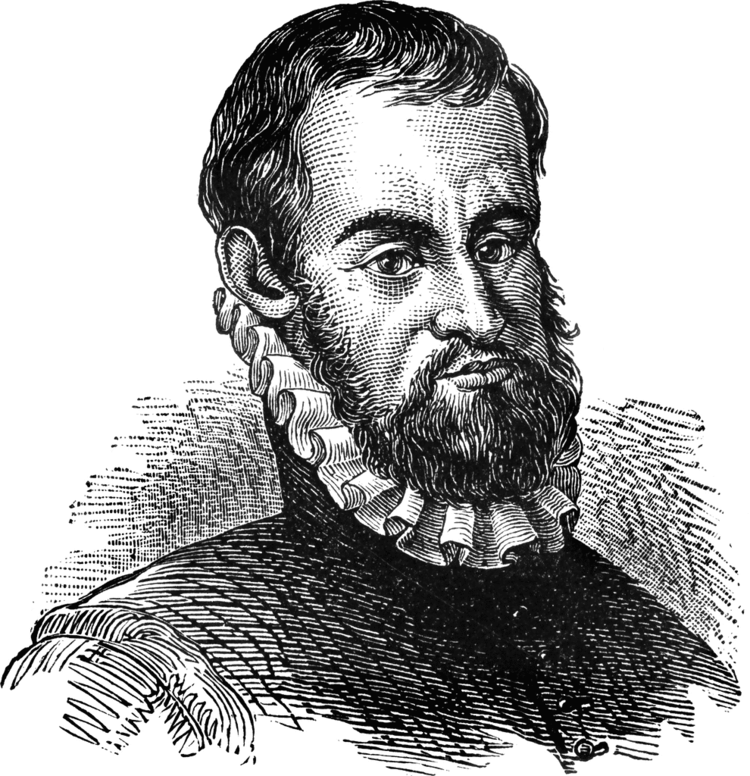
Pedro menendez de aviles
Biography
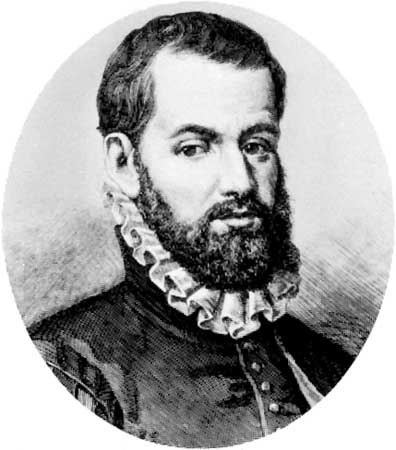
Menéndez had made his career in the Spanish Navy, in the service of the king, Philip II of Spain. His initial plans for a voyage to Florida revolved around searching for his son, Juan, who had been shipwrecked there in 1561. He could not find his son and he was assumed dead.

Following the founding of Fort Caroline in present-day Jacksonville by French Huguenots under René Goulaine de Laudonnière, he was commissioned to conquer the peninsula as Adelantado. He established Saint Augustine, or San Agustín, in 1565; then he seized Fort Caroline and displaced the French.
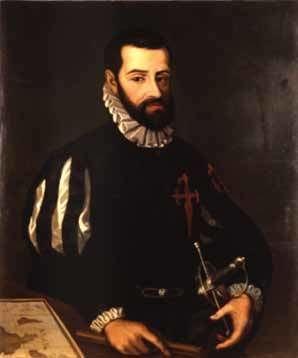
His position as governor now secure, Menéndez explored the area and built additional fortifications. He returned to Spain in 1567 and was appointed governor of Cuba, in October of that year. He voyaged to La Florida for the last time in 1571, with 650 settlers for Santa Elena, as well as his wife and family. Menéndez died at Santander, Spain, in 1574.
La Florida

In 1560, Pedro Menéndez commanded the galleons of the great Armada de la Carrera, or Spanish Treasure Fleet, on their voyage from the Caribbean and Mexico to Spain. He was appointed by King Philip II of Spain, who chose him as Captain General, and his brother Bartolomé Menéndez as Admiral, of the Fleet of the Indies. When he had delivered the treasure fleet to Spain, he asked permission to go back in search of one lost vessel which had contained his son, other relatives, and friends, but the crown repeatedly refused his request.
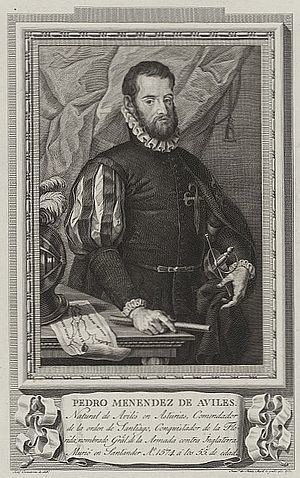
In 1565, however, the Spanish decided to destroy the French outpost of Fort Caroline, located in what is now Jacksonville. The crown approached Menéndez to fit out an expedition to Florida on the condition that he explore and settle the region as King Philip's adelantado, and eliminate the Huguenot French, whom the Catholic Spanish considered to be dangerous heretics.
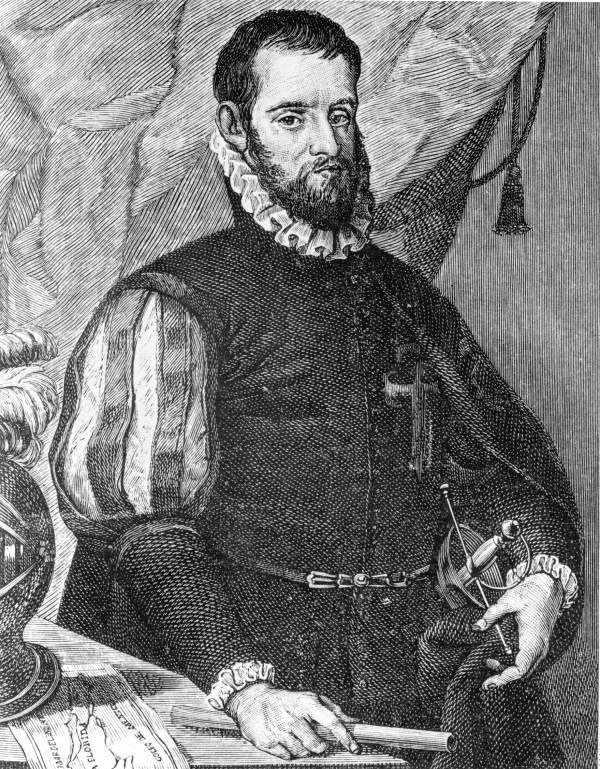
Menéndez was in a race to reach Florida before the French captain Jean Ribault, who was on a mission to secure Fort Caroline. The two fleets met in a brief skirmish off the coast, but it was not decisive. On 28 August 1565, the feast day of St. Augustine of Hippo, Menéndez's crew finally sighted land. They landed shortly after to found the settlement they named San Agustín (Saint Augustine). The settlement was founded in the former Timucua village of Seloy. The location of the settlement was chosen for its defensibility and proximity to a fresh water artesian spring. To this day, the locals of St. Augustine claim that it was here that Menéndez held the first Catholic mass in what is now the continental United States.
A French attack on St. Augustine was thwarted by a violent squall that ravaged the French naval forces. Taking advantage of this, Menéndez marched his troops overland to Fort Caroline on the St. Johns River, about 30 miles (50 km) north. The Spanish easily overwhelmed the lightly defended French garrison, which had been left with only a skeleton crew of 20 soldiers and about 100 others, killing most of the men and sparing about 60 women and children. The bodies of the victims were hung in trees with the inscription: "Hanged, not as Frenchmen, but as "Lutherans" (heretics)." Menéndez renamed the fort San Mateo and marched back to St. Augustine, where he discovered that the shipwrecked survivors from the French ships had come ashore to the south of the settlement. A Spanish patrol encountered the remnants of the French force, and took them prisoner. Menéndez accepted their surrender, but then executed all of them except a few professing Catholics and some Protestant workers with useful skills, at what is now known as Matanzas Inlet (Matanzas is Spanish for "slaughters"). The site is very near the national monument Fort Matanzas, built in 1740-1742 by the Spanish.
Military
Menéndez is credited as the Spanish leader who first surveyed and authorized the building of the royal fortresses at major Caribbean ports. He was appointed Captain-General of the Spanish treasure fleet in 1554, when he sailed out with the Indies fleet and brought it back safely to Spain. This experience assured him of the strategic importance of the Bahama Channel and the position of Havana as the key port to rendezvous the annual Flota of treasure galleons. Later, in his capacity as adelantado and the private instrument of his sovereign's will, he was required to implement the royal policies of fortification for the defense of conquered territories in La Florida and the establishment of Castilian governmental institutions in desirable areas.
Menéndez' military experience served him well when he led a successful overland expedition from St. Augustine to surprise and destroy the French garrison at Fort Caroline on the St. Johns River. On 20 September 1565, a hundred and thirty-two Frenchmen were killed within the fort; only the women and children and a few drummers and trumpeters were spared. Menéndez left a Spanish garrison at the captured fort, now renamed San Mateo (it was later destroyed and the Spanish there massacred as revenge by the French in 1568). Menéndez then pursued Jean Ribault, who had already left with four ships to attack the Spanish at St. Augustine. A storm wrecked three of the French ships near what is now the Ponce de León inlet and the flagship was grounded near Cape Canaveral. The survivors made their way up the coast to an inlet, and it was here that Menéndez ordered them to be put to death after their surrender. The slaughter of these men led to the area of their execution being called 'Matanzas' ('Massacre' or 'Slaughters'). With the coast of Florida now firmly in Spanish hands, Menéndez then set to work finishing the construction of a fort in St. Augustine, establishing missions to the natives for the Catholic Church, and exploring the east coast and interior of the peninsula.
Treasure fleet
Pedro Menéndez de Aviles was appointed Captain General of the Fleet of the Indies in 1554 by King Phillip II of Spain. This position carried great honor, and it was an unusual appointment as the Casa de Contratación in Sevilla had appointed the Captain General in the past. Phillip II and Menéndez maintained a close relationship, Menéndez was even invited to be a part of the Royal Party when Phillip married Mary I, Queen of England. Menéndez was the chief planner of the formalized Spanish treasure fleet convoy system that was to be the main link between Spain and her overseas territories. He was also the designer, in partnership with Álvaro de Bazán, of the great galleons that were employed to carry the trade between Cadiz in Spain and Vera Cruz in Mexico.
Later years
Menéndez traveled to southwest Florida, looking for his son. There he made contact with the Calusa tribe, an advanced maritime people. He negotiated an initial peace with their leader, King Carlos, which was solidified by Menéndez's marriage to Carlos's sister, who took the baptismal name Doña Antonia. The peace was uneasy, and Menéndez's use of his new wife as a hostage in negotiations with her people, as well as his negotiating with the Calusas' enemies, the Tocobagas, helped cause the decline of relations to all out war, which continued intermittently into the next century. Menéndez was unsuccessful in locating his son Juan.
Establishing a Spanish garrison of 200 men further up the coast, he sailed to what is today the Georgia coast making contact with the local Indians of St. Catherines Island before returning to Florida, where he expanded Spanish power throughout southeastern Florida. In 1567, he marched south encountering the Ais (Jece) as he reached the Indian River near present-day Vero Beach.
In December 1571, Menéndez was sailing from Florida to Havana with two frigates when, as he tells it, "I was wrecked at Cape Canaveral because of a storm which came upon me, and the other boat was lost fifteen leagues further on in the Bahama Channel, in a river they call the Ais, because the cacique (chief) is so called. I, by a miracle reached the fort of St. Augustine with seventeen persons I was taking with me. Three times the Indians gave the order to attack me, and the way I escaped them was by ingenuity and arousing fear in them, telling them that behind me many Spaniards were coming who would slay them if they found them." The Ais, like the Tequesta and Calusa tribes, proved hostile to Spanish settlement as war continued on and off until 1670.
Menéndez later made contact with the less hostile Tequesta at their capital in El Portal (Miami) and was able to negotiate for three chieftains to accompany him to Cuba as translators to the Arawak. Although Menéndez left behind Jesuit missionaries Brother Francisco de Villareal and Padre Rogel in an attempt to convert the Tequesta to Roman Catholicism, the tribe were indifferent to their teachings. The Jesuits returned to St. Augustine after a year.
In August 1572, Menéndez led a ship with thirty soldiers and sailors to take revenge for the killing of the Jesuits of the Ajacán Mission in present-day Virginia.
At the end of his life, he was appointed as governor of Cuba shortly after his arrival. He died in Santander, Spain, on 17 September 1574.
Family
Pedro Menéndez de Avilés was born to an old noble family in the kingdom of Asturias. He was one of the younger sons of Juan Alfonso Sánchez de Avilés, who had served the Catholic Monarchs in the war of Granada, and María Alonso y Menéndez Arango. His parents had twenty children, and Pedro was still a child when his father died. When Doña Maria remarried, the boy was sent to live with a relative who promised to oversee his education. Pedro and his guardian did not get along, and he ran away from home. He was found six months later in Valladolid and taken back to his foster home. Eventually he went off to fight in one of the wars with France, serving in a small armada against the French corsairs who harassed the maritime commerce of Spain.
After two years of fighting, Menéndez returned to his people, having conceived a plan to use part of his inheritance to build his own vessel. He built a patache, a small but fast row-sailer, suitable for patrolling the coast. He was then able to persuade a number of his relatives to sail with him in search of adventure. It was in this little ship that the youthful Menéndez won his first victory of command in an engagement with French corsairs who attacked three slow Spanish freighters off the coast of Galicia. Through daring and resourceful cunning he separated the two swift zabras (Biscayan frigates) that pursued him and captured them both, and drove away the third. The exploits of Pedro Menéndez soon became a topic of conversation on the waterfronts of Spain and France, and even in the royal courts. The Seville merchants and the associated Casa de Contratación (House of Trade) were chagrined by the success of Menéndez' adventures and his growing influence with the Crown. In 1561 he was jailed by Casa officials for alleged smuggling but he was able to get his case transferred to court and win his release.
Philip II was alarmed when he received the report from France of the Spanish spy Dr. Gabriel de Enveja that Jean Ribault had secured for himself the title of "Captain-General and Viceroy of New France", and that an expedition of ships, soldiers and supplies was being fitted at Dieppe for a voyage to Florida—more than 500 arquebusiers and many dismounted bronze cannons were loaded aboard the vessels. Menéndez was now available to serve the king's purposes, having been granted an appointment as adelantado of La Florida, and standing to receive a large land grant and the title of marquis if he was successful in his commission. He advised the king of the strategic importance of exploring the Florida coast for discovery of trade passages to the riches of China and Molucca—waterways that might lead to the mines of New Spain and the Pacific — and of settling in several areas to defend the territory against incursions by the Indians and foreign powers.
Menéndez expected to make vast profits for himself and to increase the royal treasury with this Florida enterprise, which was to include the development of agriculture, fisheries, and naval stores. This ambitious venture was supported materially and politically by his kinship alliance of seventeen families from northern Spain, all tied by blood relations and marriage, who pledged their persons and their fortunes to the adelantado, hoping to enrich themselves with large grants of lands and the royal honors of civil and military offices in La Florida. The support of this familial elite of partners sharing his vision of enlarged estate and enhanced prestige gave Menéndez a loyal cadre of lieutenants and officials who not only had blood connection to him, but also had invested their futures in his success.
Legacy
Pedro Menendez High School on State Road 206 in Saint Johns County is named after him, as well as several streets in the area.
